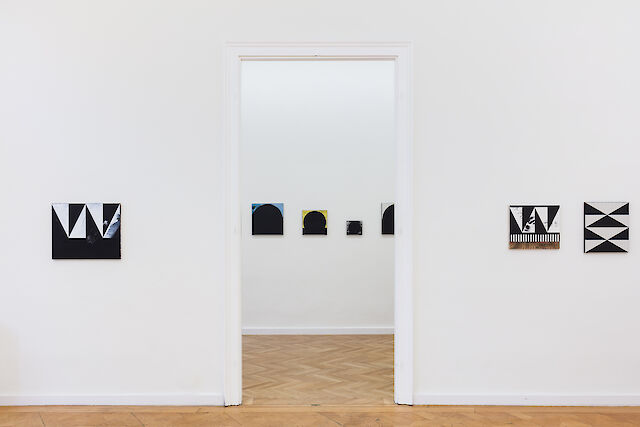Images
and bluff is a colour
2. 6. – 3. 7. 2021

Nicolas Jasmin, installation view and bluff is a colour, Croy Nielsen, Vienna, 2021

Nicolas Jasmin, installation view and bluff is a colour, Croy Nielsen, Vienna, 2021

Nicolas Jasmin, installation view and bluff is a colour, Croy Nielsen, Vienna, 2021

Nicolas Jasmin, Untitled (dretripil), 2021, laser etched mixed media on hessian, 35 × 40 cm

Nicolas Jasmin, installation view and bluff is a colour, Croy Nielsen, Vienna, 2021

Nicolas Jasmin, installation view and bluff is a colour, Croy Nielsen, Vienna, 2021

Nicolas Jasmin, installation view and bluff is a colour, Croy Nielsen, Vienna, 2021

Nicolas Jasmin, Untitled (dretriquad), 2021, laser etched mixed media on hessian, 31 × 31 cm

Nicolas Jasmin, installation view and bluff is a colour, Croy Nielsen, Vienna, 2021

Nicolas Jasmin, Untitled (dretrimold), 2021, laser etched mixed media on hessian, 33 × 21 cm

Nicolas Jasmin, installation view and bluff is a colour, Croy Nielsen, Vienna, 2021

Nicolas Jasmin, Untitled (dretri), 2020, laser etched mixed media on hessian, 30 × 40 cm

Nicolas Jasmin, Untitled (setrimir), 2021, laser etched mixed media on hessian, 25 × 50 cm

Nicolas Jasmin, Untitled (setri) #2, 2020, laser etched mixed media on hessian, 33 × 21 cm

Nicolas Jasmin, Untitled #1 (dretri), 2020, laser etched mixed media on hessian, 31 × 31 cm

Nicolas Jasmin, Untitled (dretrizentra), 2021, laser etched mixed media on hessian, 45 × 55 cm

Nicolas Jasmin, Untitled (zwetri), 2020, laser etched mixed media on hessian, 33 × 21 cm

Nicolas Jasmin, installation view and bluff is a colour, Croy Nielsen, Vienna, 2021

Nicolas Jasmin, installation view and bluff is a colour, Croy Nielsen, Vienna, 2021

Nicolas Jasmin, Untitled #E1 (E not E), 2018, laser etched mixed media on hessian, 31 × 31 cm

Nicolas Jasmin, Untitled #19.1 (E not E), 2017–2021, laser etched mixed media on hessian, 31 × 31 cm

Nicolas Jasmin, Untitled #6 (E not E), 2018, laser etched mixed media on hessian, 31 × 31 cm

Nicolas Jasmin, Untitled #40 (E not E), 2018, laser etched mixed media on hessian, 31 × 31 cm

Nicolas Jasmin, Untitled (XIV komposition nr.1), 2021, laser etched mixed media on hessian, 45 × 55 cm

Nicolas Jasmin, Untitled (XIV komposition nr.1), 2021, laser etched mixed media on hessian, 45 × 55 cm

Nicolas Jasmin, Untitled (MOON), 2020, laser etched mixed media on hessian, 55 × 45 cm

Nicolas Jasmin, Untitled (MOON), 2020, laser etched mixed media on hessian, 55 × 45 cm

Nicolas Jasmin, installation view and bluff is a colour, Croy Nielsen, Vienna, 2021

Nicolas Jasmin, Untitled (BLUFF), 2020, laser etched mixed media on hessian, 55 × 45 cm

Nicolas Jasmin, Untitled (KING), 2019, laser etched mixed media on hessian, 55 × 45 cm

Nicolas Jasmin, Untitled (SILENZIO!), 2019, laser etched mixed media on hessian, 55 × 45 cm

Nicolas Jasmin, Untitled (PUDEL), 2019, laser etched mixed media on hessian, 55 × 45 cm

Nicolas Jasmin, Untitled (SKEPSIS), 2019, laser etched mixed media on hessian, 75 × 55 cm

Nicolas Jasmin, Untitled (REALITY), 2019, laser etched mixed media on hessian, 55 × 45 cm Photos by Kunst-dokumentation.com
Press Release
Ce que nous voyons, ce qui nous regarde.*
Nicolas Jasmin’s paintings are self-referential and full of references. They are at once transparent and opaque, of conceptual rigor and enigmatic playfulness. Hand meets machine, painterly gesture meets linear laser beam, rough materiality meets smoothed surface, addition meets subtraction. The motifs that Jasmin uses in mostly extensive groups of works also correspond to this constant oscillation between opposites: he prefers to bring geometric forms and monochrome surfaces, figure and ground, image and text into a mutually dependent interrelationship. Despite, or perhaps because of, the simplicity and transparency of their compositions, Nicolas Jasmin’s paintings have an immense attraction that testifies to a life of their own that looks back at us, that concerns us.
While the works from the Adler Cycle demonstrate the aspect of self-referentiality (a monochrome color surface is treated with a laser in such a way that the upper half of the image is matte and the specific designation by the color producer Adler, such as “REALITY”, “TAKTIK” or “BLUFF” appears on the lower edge), the Enigma Paintings (E not E) evoke an associative conundrum between figuration and abstraction, figure and ground, whose appeal lies not in explanation but in its constantly reactivated enigma. The most recent group of works, Guardians of Secrets, takes a literal look at the unconscious in images: Jasmin appropriates a combination of black and white stripes and triangles (resembling stylized eyes), which he reduces, duplicates, mirrors, recombines, and deconstructs. The beguiling suggestiveness of the geometric-constructivist black-and-white contrast makes us think of the distinct local variant of a “constructive” Art Nouveau style of the Vienna Secession and the Wiener Werkstätte at the beginning of the 20th century. Nevertheless, the origin of this motif can be found in a tapa, an ornamented bark cloth, produced in the 19th century in Fiji. The history of geometric abstraction is neither “pure” nor “purely European”; rather, it is riddled with transcultural entanglements, circulations, subjugations, and appropriations. Like projections, Jasmin’s Guardians, bring to light the overlooked – it looks back at us and it concerns us.
Luisa Ziaja
* Georges Didi-Huberman, Ce que nous voyons, ce qui nous regarde [What We See Looks Back at Us], Paris 1992. Didi-Huberman activates the double meaning of the original “regarde”, which means both “to look at” and “to concern”, in the sense of an uneasiness that arises when we “really” look at something (not overlook or suppress it) and are thereby looked at by it in reverse.